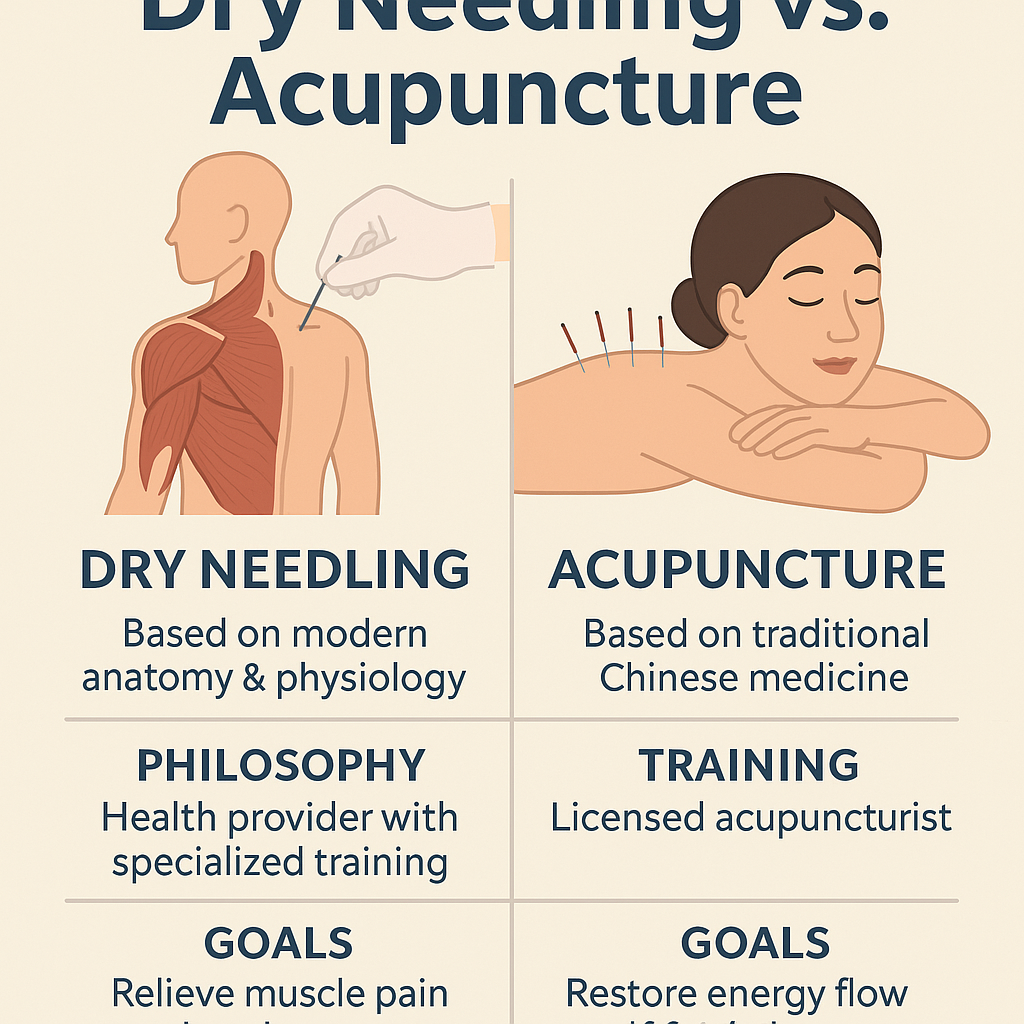Introduction: Clearing Up the Confusion
Many patients hear about both dry needling and acupuncture and wonder — aren’t they the same thing? Both techniques use thin, sterile needles, and both can be highly effective for pain relief and healing. But while they may look similar on the surface, dry needling and acupuncture are based on very different philosophies and training standards.
At Aiello Family Chiropractic in Franklin, TN, we provide both approaches in a professional, integrative setting. Here’s a detailed look at how dry needling and acupuncture differ, and how each might play a role in your care.
What Is Dry Needling?
Dry needling is a modern therapeutic technique used primarily by physical therapists, chiropractors, and other licensed providers. The term “dry” means that no medication or fluid is injected — only a thin, solid needle is used.
How It Works
- The practitioner inserts the needle directly into a trigger point — a tight knot in muscle fibers that can cause local pain or referred pain in other areas.
- The goal is to release muscle tension, improve blood flow, and reset neuromuscular patterns.
- Patients may feel a quick twitch response, followed by relaxation of the muscle.
Common Uses
- Myofascial pain
- Sports injuries
- Chronic tension in the neck, shoulders, or back
- Postural dysfunction
- Joint pain linked to muscle tightness
What Is Acupuncture?
Acupuncture is a practice rooted in traditional Chinese medicine (TCM) and has been used for thousands of years. It involves inserting thin needles into specific points on the body that correspond to pathways of energy, known as meridians.
How It Works
- Acupuncture points are chosen based on patterns of imbalance in the body’s energy flow, or Qi (chi).
- Stimulating these points can influence the nervous system, improve circulation, reduce inflammation, and balance organ function.
- The focus is not only on local pain but also on restoring whole-body harmony.
Common Uses
- Pain relief (back, neck, headaches, arthritis)
- Anxiety, stress, and insomnia
- Digestive issues
- Allergies and respiratory concerns
- Women’s health (menstrual pain, fertility support, menopause symptoms)
Key Differences Between Dry Needling and Acupuncture
1. Philosophy
- Dry Needling: Based on modern anatomy, neurology, and musculoskeletal science. Focuses on trigger points and muscle tension.
- Acupuncture: Rooted in traditional Chinese medicine. Focuses on balancing energy (Qi) and influencing the body’s internal systems.
2. Training
- Dry Needling: Often performed by chiropractors, physical therapists, or other healthcare providers with specialized training courses.
- Acupuncture: Requires extensive education, usually a Master’s degree in Acupuncture or Oriental Medicine, plus state licensure.
3. Treatment Goals
- Dry Needling: Relieve local pain, improve mobility, and reset muscle function.
- Acupuncture: Support systemic health, improve overall balance, and treat a wide range of conditions.
4. Technique
- Dry Needling: Needles are typically placed directly into tight muscles or tender trigger points.
- Acupuncture: Needles are placed along specific meridians, which may be distal (far away) from the site of pain.
When to Choose Dry Needling vs. Acupuncture
Both therapies can be beneficial, and sometimes patients benefit from a combination of the two.
- Choose dry needling if:
- You have a localized muscle knot or sports injury
- You want targeted relief for trigger points or postural issues
- You’re seeking a modern, anatomy-based approach
- Choose acupuncture if:
- You have multiple or complex health issues (pain + stress + sleep problems)
- You want to improve overall wellness and body balance
- You’re interested in a holistic, whole-body approach
At our Franklin TN clinic, we help patients decide which option is best during their consultation.
Complementary Benefits: Using Both Approaches
Some patients may benefit from both therapies at different times. For example:
- A runner with calf tightness may use dry needling for immediate trigger point release, and acupuncture to support circulation and recovery.
- A patient with chronic neck pain may benefit from dry needling for muscle release and acupuncture for stress reduction and sleep support.
By offering both services, we provide a comprehensive and flexible approach that adapts to each patient’s unique needs.
Safety and Comfort
Both dry needling and acupuncture are safe when performed by trained professionals. At Aiello Family Chiropractic, we use sterile, single-use needles and follow all safety protocols. Patients often describe the sensation as a quick pinch or dull ache, followed by relaxation.
Side effects are usually minimal and may include mild soreness or temporary fatigue — both signs that the body is responding to treatment.
Why Choose Aiello Family Chiropractic for Dry Needling in Franklin, TN?
- Integrative Approach: We offer dry needling, acupuncture, chiropractic, massage, and more under one roof.
- Experienced Providers: Our team is trained in both anatomy-based and holistic approaches.
- Customized Care: Each treatment plan is tailored to your condition, lifestyle, and goals.
- Local Expertise: Serving patients from Franklin, Cool Springs, and the greater Nashville area.
When you search for “dry needling Franklin TN”, we want you to know you’re in the right place for trusted, comprehensive care.
Conclusion: Different Tools, Shared Goal
While dry needling and acupuncture use similar tools, their foundations and applications are very different. Dry needling targets muscle knots and trigger points, while acupuncture restores systemic balance and supports whole-body wellness.
At Aiello Family Chiropractic in Franklin, TN, we’re proud to offer both therapies in a supportive, integrative environment. Whether you’re struggling with chronic pain, muscle tension, or broader health concerns, our team can help you find the right path to relief.
📞 Call today or schedule online to learn more about how dry needling and acupuncture can support your healing journey.
